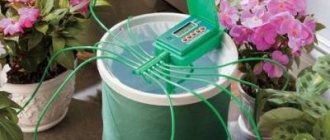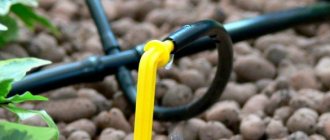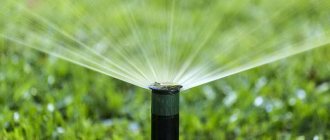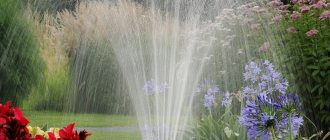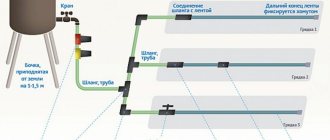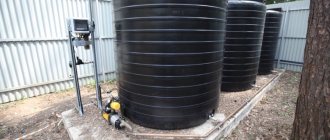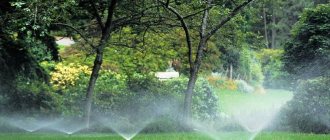With the dry season approaching, the entire garden may be at risk if you do not take care of watering the plants in time. Thanks to proper organization of watering at your dacha, you can not only grow healthy and beautiful plants, but also significantly save water and time. An automatic drip irrigation system will help you with this.
Drip irrigation is an irrigation method in which water flows directly to the root system of plants. This allows you to save water and other resources: time, energy and fertilizers.
In the case of drip irrigation systems, you do not waste excess water on watering weeds and do not get on the leaves of plants, which prevents the appearance of fungus and mold. It also minimizes water evaporation and ensures that you don't wash away treatments or fertilizers. This method has been proven to work better than the usual garden hose or sprinkler sprinklers.
Types of irrigation are divided into several types and each has its own advantages. Which system will be better? Tape or tubular? How to choose a system for my garden? We will analyze the answers to these and other questions using this material.
What is a drip irrigation system?
A drip irrigation system is one of the micro-irrigation methods that saves water and allows it to efficiently flow to the right place in the right quantity. Of course, from the outside it may seem that the system is working very slowly, but in reality this is not the case. Water drips directly into the root zone and this minimizes the percentage of evaporation.
Typically a drip irrigation system consists of:
- A timer that allows you to regulate the flow of liquid;
- Strainer
- Liquid reservoir (possibly with added fertilizer)
- Pipe systems;
- Pegs that supply liquid directly to the root of the plant (in the case of tubular root irrigation).
What are the advantages
Not every gardener is ready to water the plantings manually or constantly move hoses and sprinklers around the site. There are more modern and practical options: drip irrigation systems. You can buy them ready-made or assemble them yourself. A high-quality system, selected taking into account the water supply and the terrain of the site, operates for several years without needing repairs. At the end of the season it is dismantled, and in late spring, when the ground has completely thawed, it is reinstalled.
In greenhouses and greenhouses, drip irrigation allows not only to ensure the supply of water to the roots of plants, but also to maintain the necessary air humidity. In heated shelters, the system can operate all year round.
The operating principle of the drip system is not complicated. Water is supplied from the water supply (flow-through type) or comes from a separate container. The supply is regulated using a tap. The water then passes through a filter and irrigation controller, which distributes the moisture through supply pipes or belts. They are distributed between plants, water goes directly to the roots through small holes.
Among the advantages of the drip system:
- saving water;
- the ability to water at any convenient time;
- ensuring the level of humidity required for a specific crop;
- ease of installation, use and repair;
- affordable price;
- spot watering reduces the number of weeds on the site;
- The finished set can be improved by purchasing additional elements.
Expert opinion
Kuznetsov Vasily Stepanovich
A correctly selected and installed system does not spoil the appearance of the site: it is simply not noticeable under the lush foliage. If necessary, it can be increased by adding additional hoses. Transmission lines do not injure plants or interfere with their development.
Advantages of drip irrigation for gardening and vegetable gardens
If we compare manual watering from a hose and drip irrigation, the latter is based on the dosed supply of liquid to the root part of the plant, and the frequency and level of liquid can be adjusted depending on the needs of the plant.
Key advantages of drip irrigation compared to other methods:
- Maximum soil ventilation.
The device allows you to retain as much moisture in the soil as the plant needs. With this method, the roots breathe freely throughout the entire growing season; - Active root development.
This method allows you to speed up the development of plant roots compared to other watering methods. Most of the root system is in the zone of action of drip irrigation, which promotes the development of root hairs and also allows you to increase the amount of absorbed minerals; - Better absorption of fertilizers.
Since nutrients are introduced into the root zone at the point of watering, this allows plants to quickly and intensively absorb mineral and organic fertilizers. This method of feeding is considered the most effective, especially during drought; - Plant protection.
If we compare this method with sprinkling, then during the process of drip irrigation the leafy part of the plant does not get wet. This helps reduce the likelihood of developing diseases, and the treatment that was carried out against diseases and pests is not washed off from the leaves; - Minimum labor costs.
The system is completely autonomous and allows the owner to get rid of daily manual watering using a hose; - Saving.
Drip irrigation allows you to save up to 70% of water, as wasteful expenses are reduced to a minimum. Water is dosed only to the necessary places.
Video description
Useful video on the topic:
See also: Catalog of companies that specialize in the installation of metal structures - canopies, greenhouses and others
Timers can operate from mains or batteries, be mechanical, electro-mechanical or electronic:
- The mechanical timer is manually controlled and has only one function. Before you start watering, you need to turn it on and set the time after which it will stop supplying water. This device is convenient if the area is small and is under constant supervision. It eliminates the need to turn off the water on time and generally keep this concern in mind.
- The electronic-mechanical device can already do more: it provides the specified frequency and duration of watering, independently controlling the system in accordance with the program.
Electronic-mechanical timer with output to two lines Source growsvet.ru
- Electronic controllers are capable of executing up to 16 commands when connecting to them additional devices that monitor soil and air humidity, temperature and other environmental parameters. They can be programmed to different modes for each crop. They are expensive, but they allow you to not have to worry about watering at all, no matter what the weather is like outside and no matter how long the owners’ absence.
When deciding how to make automatic watering in a greenhouse with your own hands, you need to decide in advance on the optimal irrigation mode and choose the most suitable timer in terms of price and functionality. It is installed at the beginning of the system on the main line and does not particularly complicate the process of its assembly.
Electronic timer connected to the central water supply Source treetrekkers.com
Types of drip irrigation
Drip irrigation systems are classified into groups based on their type of design and the method by which they deliver water to plants and trees. In the previous article we talked in detail about watering for trees and shrubs, and in this material we looked at the types of watering depending on the method of water supply - manual or automatic.
In this article we will analyze the other two well-known classifications of drip irrigation based on their design - tubular and tape. If necessary, all two types can be used harmoniously together.
Tubular irrigation
This type of drip irrigation consists of a main polyethylene water pipe that is connected to a water source. The pipes are made of a dark color so that during the irrigation process the water passing through the pipes has time to heat up. Secondary pipes of the same size extend from the main pipe, and the system is laid on the soil at the base of the plants. Next, water is supplied to each plant using special droppers through the system. Droppers are installed in a convenient location on the pipe; to do this, a hole is simply made in the pipe with a special hole punch and a dropper is inserted into it.
If water will be supplied directly from the water supply, you will need a pressure reducer. This is a device that stabilizes and reduces pressure in the water supply network, thereby protecting both the pipeline itself and the irrigation system connected to it from high pressure.
And if you want to automate the watering process, choose options with a watering timer. Thanks to it, you can adjust watering in accordance with your garden characteristics. You can set the duration and frequency of watering on the timer. In this article we talked about the advantages of watering timers and their use on the farm.
This type of irrigation is designed for several years. For the winter, it must be drained and either tied to the top of the greenhouse or stored indoors.
Tape irrigation
Another equally popular type of drip irrigation is tape. Such irrigation will be cheaper than tubular irrigation due to the use of drip tapes in the irrigation process. Also, it usually does not require special settings, but is suitable for watering only one type of crop, for example, potatoes, berries or tomatoes. It is called tape because the tubes are made of a thin layer of polyethylene and when empty the tube is flattened and looks like a tape. But as soon as you throw water into it, it inflates and becomes a tube.
The operating principle of the systems is very simple: using tubes with holes called emitters, water is distributed throughout the area and supplied to the plants. The service life of the system itself is usually one to two years, then it becomes clogged or breaks.
Drip tape often does not require high water pressure, since watering occurs due to special emitters, which are located at a distance of 20 or 30 cm from each other, depending on the selected tape. Thanks to them, when water arrives, gradual irrigation of the land begins.
What is the difference between a tubular system and a belt system?
The key difference between strip irrigation and tubular irrigation is the absence of regulation of the droppers, since the irrigation itself already has holes at a distance of 20 or 30 cm from each other. This can be inconvenient if you have already planted a vegetable garden and are choosing an irrigation system for it, and not vice versa.
It makes sense to buy a tape one when the plants have not yet been planted, since you can place the plants at a strict distance from each other.
What are the advantages of such irrigation systems?
One of the advantages of drip irrigation is the slow delivery of water. Because water drips slowly over a long period of time, it penetrates deeper, covering a larger area and reaching the roots. This results in stronger root systems and healthier plants.
All of these systems are easy to install, despite the fact that they consist of many components. Additionally, it is always useful to be able to customize the setup the way you want and the way your crops require it. You can water multiple zones at once or prevent it from flowing into other zones when you need them and run them on a timer to water at the right time.
You can also adapt the system to hilly and uneven terrain by adjusting the pressure or changing it depending on the soil type. For example, if your soil is sandier, water will drain faster, so you can increase the drip rate.
Which is better: a tubular or strip drip irrigation system?
Unfortunately, there is no clear answer to this question. Ultimately, which one is right for you depends on several factors.
First, think about the type of garden you have. If it is small and relatively level, tape irrigation will work better for you. If necessary, you can wrap this system around the entire garden in rows or in a snake.
Tubular systems are better suited for larger gardens, including those on a slope or hill. They are more versatile and last longer, so you will get much more benefit and efficiency from them.
Main classification
The systems on the market are divided into several categories: hose and belt, operating from a separately installed container or water supply. The designs differ in the type of water supply, manual or automatic adjustment, ground or underground installation.
The choice depends on the characteristics of the site and its size, the needs of the plants, the financial capabilities of the gardener and his personal preferences.
Review of drip irrigation systems from MasterProf
The simplest option is a ready-made drip irrigation kit, which contains all the necessary components to create an automated system. All you need to do is read the instructions and install it yourself on your site.
Tubular set “Water”
Provides convenient and gentle watering of plants both in greenhouses, greenhouses, and in open ground. The kit is designed to organize a dosed supply of water to the root zone of plants that require “warm” watering (pumpkin, tomato, cucumber, zucchini, pepper, eggplant). For its stable operation, you will need a barrel of water installed at a height of at least 1.5 meters above the ground. Before installation, it is recommended to heat the drip tube in hot water. The water supply is controlled using a tap.
- Proper supply significantly saves water;
- Water goes directly to the plant itself;
- The flexible tube can be positioned along a complex perimeter;
- Automatic watering is possible at night;
- Easy to use;
- It is enough to place the tape over the area intended for irrigation and connect it to a water source.
This set is designed to water 28 plants. Thanks to the quality of the components, “Vodyanoy” can be used for more than one season, eliminating the need for an annual purchase. With the help of additional components included in our range, you can expand the device to any number of plants.
ORDER ONLINE:
No
829
759
1322
Set contents
- Tube - 10 m;
- Clamp - 1 m;
- Tap for connecting the tube to a hose of 16 diameters - 1 piece;
- Tee - 1 piece;
- Corners - 2 pcs;
- Plugs - 2 pcs;
- Tee for dropper - 14 pcs;
- Droppers: 28 pcs;
- Hole punch - 1 pc.
Tape system "Droplet"
MasterProf Tape drip irrigation system, DS.060053 - a high-quality and reasonable solution to the problem of watering beds and vegetable gardens in general. A thoughtful design ensures convenient and gentle watering of plants in gardens and vineyards.
To work, you will need a barrel of water installed at a height of at least 1.5 meters above the ground, which will create the necessary working pressure. Irrigation is carried out through emitters - flat droppers distributed on a tape in increments of 30 cm.
A tape irrigation system is significantly cheaper than a tubular one and does not require manual adjustment. This set is ideal for plantings of the same type, for example, tomato plantations, potato beds.
The “Droplet” set as standard is designed for four ten-meter beds and is connected to a container of water installed at a height of no lower than 1.5 meters from the ground. Thanks to the tape with 0.2 mm walls, it is suitable for any planting, is guaranteed to last for several years, and does not suffer from rodents and insects and random stones. The hose is equipped with holes located at a distance of 30 centimeters from each other. The kit includes all the elements for installing a full-fledged system; if desired, it can be expanded by purchasing additional components for a certain number of beds.
The main advantage of the system is the price-quality ratio, as well as simple installation that does not require specific skills. It is recommended to purchase an additional filter to avoid blockages when watering.
ORDER ONLINE:
651 rub.
690 rub.
659 rub.
715 rub.
Equipment:
- Tape - 40 m;
- Tube with a diameter of 16 mm - 10 m;
- Tap for connecting the tube to a hose of 16 diameters - 1 piece;
- T-shaped adapter - 4 pcs;
- Tape plugs - 4 pcs;
- Tube plug - 1 piece;
- Clamp - 1 pc.
Operating pressure in drip tape
Since the drip tape has fairly thin walls, it cannot operate at high water pressure, which is, for example, in a standard water supply network. Typically the tape can withstand a maximum pressure of 0.7-1 bar. At higher pressure it will simply burst!
You also need to consider the minimum pressure at which the drip tape can operate. Different manufacturers indicate from 0.2 to 0.5 bar, which means raising the water container to a height of 2 m. Some tapes, according to the manufacturers’ characteristics and the experience of gardeners, work well already at a pressure of 0.1 bar (1 m from the ground) .
To reduce the pressure of water coming from the water supply network to the operating range of the drip tape, special pressure reducers are used.
How to calculate the required tank volume?
The volume of the tank that needs to be used for drip irrigation is calculated quite simply. To do this, the area of the site that is planned to be irrigated is multiplied by 20 liters - this is exactly the amount of liquid that will be needed to moisten 1 square meter of territory.
Important fact! The estimated amount of liquid in the barrel should be sufficient to produce a one-time (daily) drip irrigation.
Let's look at a more detailed calculation example:
If the greenhouse measures 10 m by 3.5 m, then the area of the greenhouse will be 10 m x 3.5 m = 35 square meters. Next you need to multiply 35 square meters by 20 liters, and you get 700 liters. The calculated result is the volume of the tank that is required to operate the drip irrigation system.
If you use root drip irrigation, then half of this volume will be enough, since the water will go directly to the root of the plant.
Important point: To create the necessary pressure in the system, the barrel must be at a height of at least 1.5-2 meters!
Calculation of watering time and volume of liquid supplied
The system design allows you to calculate water consumption and tank volume. Calculation example:
- highways - 15 m;
- between nozzles - 20 cm;
- required number of droppers - 1500/20=75 pcs.;
- consumption of one - 2 liters per hour;
- all nozzles - 2*75=150 l;
- barrel size - 150.
A long system will require a larger capacity, so several devices are usually made.
Individual watering times are calculated for each plant. Devices that consume 2 liters per hour include:
- cucumbers - for 60 minutes;
- tomatoes - 45 minutes;
- cabbage - 75 min.
What should the water be for drip irrigation?
Water for a drip irrigation system can come from wells, ponds, rivers, lakes, municipal water systems, or plastic-lined pits. Water from these sources will vary greatly in quality.
Well water and city water are usually clear and may only require a strainer or disc filter to remove particles. However, no matter how clean the water appears, before installing any drip irrigation system, it is necessary to have the water tested or tested to determine if there is sediment or other contaminants in the water.
This water quality test should detect inorganic solids such as sand and silt; organic solids such as algae, bacteria and mucus; dissolved solids such as iron, sulfur, sodium chlorides and calcium; water pH level.
Important! Use only water at room temperature for irrigation. Liquid that is too cold can be detrimental to plant health.
If necessary, you can add liquid fertilizers to the tank, which the irrigation system will deliver to your plants along with water.
Purpose of fittings
The system can be simply assembled using special fittings for drip irrigation. Fittings can be with or without taps. The former are more convenient to use, since, if necessary, they allow you to locally shut off the water supply. Regulation of water consumption is also required if certain zones consume it less than others or for alternate watering of different areas.
Start connectors are used to connect drip tape to a plastic water pipe. They are made with a rubber seal or a clamping nut. Holes are drilled in the HDPE pipe using a wood drill with a centering spike and start connectors are tightly inserted with or without taps.
Drip irrigation fittings, angled or in the form of tees, are used to connect the tape to a flexible garden hose. They are also used for branching or turning. The fitting seats are made in the form of ruffs, which ensures tight fastening of the tubes.
The repair fitting is used in case of a break or to extend the drip tape. With its help, its ends are connected.
Do you need to automate the watering process?
Of course, the automatic drip irrigation process will significantly save your time and facilitate the procedure of moistening the soil in the greenhouse. It is worth noting that it is worth automating the watering process only if there is a constant source of liquid supply.
Therefore, after weighing all the pros and cons, you should decide on automating the watering process, based on personal preferences and capabilities. It should be borne in mind that automating the process will require the purchase of additional elements for your system, which will increase the cost of the device, but at the same time simplify the process of caring for plants and save your time.
Water consumption by drippers
One of the most important indicators of a drip tape is the pouring of liquid from each dropper over a certain period of time. When choosing water flow, you need to take into account a number of factors: type of source, water quality, length of the tape, crop moisture requirements, method of planting and the ability of the soil to absorb water.
Based on the level of water consumption per dropper, 3 types of emitters can be distinguished:
- consumption per 1 emitter 2.0-4 l/h – increased water consumption. Excellent for crops with a developed root system that require a lot of water. Often used in a two-row planting scheme, and is also indispensable on sandy soils with rapid absorption;
- consumption per 1 emitter 1.0-1.5 l/h - standard flow. Recommended for most crops and soil types;
- consumption per 1 emitter 0.6-0.8 l/h - economical water flow. Effective for very long irrigation lines, for water sources with low productivity, as well as for soils with low moisture rates.
How does drip irrigation save water?
Water is conserved through drip irrigation in the following ways:
- The uniformity of drip irrigation operation is usually more than 90%;
- Unlike other irrigation systems, drip irrigation supplies water directly to the soil, eliminating water loss due to wind or sun;
- Water can be applied directly to the crop or plant root zone in the desired proportion (even daily or hourly). Other watering methods require higher water volumes and very low frequency;
- The irrigation system easily adapts to irregularly shaped planting areas that are difficult to manage with sprinklers or hand irrigation.
Water purification
Particular attention should be paid to the purification of irrigation water. Otherwise, all drip irrigation lines may fail in the middle of the season - the drippers quickly become clogged with dirty water. For slotted tape, this issue is more critical than for emitter tape.
Important: special attention must be paid to cleaning irrigation water, otherwise all drip irrigation lines may fail in the middle of the season.
Moreover, the lower the water consumption of the dripper, the thinner the channels for releasing water, which means that filtration must be carried out more thoroughly. You can focus on the following indicators:
- if the water flow rate of the dripper is less than 1.0 l/h, then increased filtration is required due to very thin channels for water release;
- if the water flow rate of the dropper is more than 2.0 l/h, then such a tape is less sensitive to the quality of water filtration.
What crops are suitable for using an irrigation system?
Key crops that are suitable for a drip irrigation system:
- Fruit: grapes, banana, pomegranate, orange, citrus, mango, lemon, apple, sapota, guava, pineapple, papaya, lychee, watermelon;
- Vegetables: tomatoes, chillies, peppers, cabbage, cauliflower, onions, okra, brinjal, pumpkin, cucumber, carrots, peas, spinach, potatoes, zucchini;
- Floral: rose, carnation, gerbera, anthurium, orchids, jasmine, dahlia, marigold;
- Plantation: rubber, coffee, coconut;
- Spices: turmeric, cloves, mint;
- Oilseeds: sunflower, oil palm, peanuts.
All types of tapes
Let's take a closer look at the features of drip tapes.
Slotted
In a slit system, the drippers are a series of small holes or slits.
They are the easiest to maintain, but require the installation of filters, since the slot openings are prone to clogging.
The peculiarity of the slotted tape is that there is a labyrinthine channel inside it, designed to slow down the movement of water.
Thus, it is evenly distributed along the entire length of the highway. To avoid clogging the network, only clean, filtered water should be used.
Interesting! Modern drip irrigation systems have built-in self-cleaning mechanisms.
Emitter
The emitter system contains droppers of a special flat shape. Drippers are installed at a certain pitch, which must be taken into account when laying irrigation lines.
In these structures, water moves according to a turbulent or flow principle, ensuring the washing out of foreign particles and preventing the formation of blockages.
Emitter systems are the most reliable and practical type of drip tapes, although more expensive.
Labyrinth
The labyrinth system contains a tortuous channel, similar to a zigzag or labyrinth, applied to the surface of the material. By slowing down the flow of water, it streamlines its supply and minimizes consumption.
Today, labyrinth-type systems are rarely used, since caring for them is associated with a number of difficulties. When unwinding the tape, the labyrinth is subject to mechanical damage.
In addition, the uniformity of watering suffers. The slot scheme, where the labyrinth is located inside a guide tube or tape, is an improved version of the labyrinth drip network.
Why will plants benefit from drip irrigation?
Just like people, plants like to receive water and nutrients in a balanced way. Nobody wants to eat a month's worth of food in one day, and the same goes for plants. Therefore, the drip irrigation system applies water and nutrients quite frequently and in small doses, providing optimal conditions for growth.
At the moment, we know for sure that plants feel better with a drip irrigation system due to the following reasons:
- High availability of water and nutrients;
- The amount of water and nutrients are adapted to the development of different plants;
- High salinity caused by excessive fertilization is avoided;
- Lack of wetting of the foliage prevents the appearance of fungal diseases.
DIY dropper
Before you start assembling the entire structure, you need to decide on the general scheme. The easiest way would be to sketch this diagram on a separate sheet, indicating all the wiring elements on the site. There you also need to indicate each distance, each dropper and the place where the water container is supposed to be located (or another source from which it will come).
IMPORTANT! You can avoid unnecessary expenses on pumping equipment if you try to place the liquid container as close as possible to the irrigated beds. And it is worth remembering that the container must be installed at a height of at least one meter!
Next, you need to decide on the mechanism (pump) for supplying/absorbing water. It can be superficial or submersible.
Surface – perfect for a storage source. This device is small in size, weighs little and takes up little space. In addition, the noise level during its operation is quite low, so it will not create discomfort either for the owner of the site or his neighbors. At the same time, using this unit it is quite possible to correctly regulate the pressure force. However, you must constantly ensure that large particles of sand, dirt or debris do not enter the device.
Submersible - the choice in favor of this sample is worth making if you intend to use an external reservoir as a source of water, and it is located not far from the garden plot. The same will apply to the situation when water has to be taken from a well. It should be noted right away that the pump will operate quite loudly, and if the water in the source has foreign impurities, then it is better to immediately consider a model with a drainage effect (they can even have their own grinders installed, so even fairly large debris will not become a hindrance).
Tips for using drip irrigation
No matter what type of watering you use, there are a few things you can do to get the best results. Here are some tips to follow:
- Cover your irrigation system with a few inches of mulch. The mulch will protect the tubes from the sun and will also act as an anchor to hold them in place. Some drip irrigation systems can be placed under the soil;
- It is best to secure the lines in place every 20-30cm using U-shaped wire or landscape staples. This way you can make sure the water goes exactly where you want it and you don't have to worry about wind or rain;
- Check the amount of water your system drains regularly. This is the best way to make sure your plants are getting exactly what they need;
- Use a water meter to measure water flow if you need accurate readings;
- If your system has inline filters, clean them at least once a season to remove rust and debris. Inspect the tubes regularly, eliminating kinks and making sure that the holes are not blocked by anything;
- Drip irrigation systems do not tolerate cold weather. If you live in a climate where winters are very cold, drain the water thoroughly at the end of the season and store all lines covered until the season begins.
Proper irrigation system for your plants, especially during the dry season, is an important aspect for their proper and healthy growth.
Among all types of irrigation, drip irrigation is the best for use in the country. Unlike other systems that consume a significant amount of water, drip irrigation is very effective, since it provides plants with a sufficient amount of water every hour, making it possible not to do manual watering at the dacha, but to entrust everything to automated systems. Enjoy your garden, don't work for it.
We hope that our material was useful to you. In the catalog of the MasterProf online store you can find the best drip irrigation option for yourself. We have many options for any type of garden.
Which one is better to choose?
The choice of a drip irrigation system largely depends on the area for which it is purchased. Next will be given lists of selection criteria for a vegetable garden and greenhouse.
For the city
A vegetable garden involves planting plants in open ground. When choosing an irrigation system you need to consider:
Total plot size .
For areas larger than 1 hectare, a drip tape system is suitable. The hoses are easier to install and are quite easy to lay along the beds. For small areas, pipe irrigation is the best option. The system is more reliable and can last more than 10 years.- Features of the soil . On hard ground with a lot of stones, it is better to purchase a pipe system. For sandy or fine-grained clay soils, it is better to purchase belt irrigation. It is cheaper and will not suffer from soil conditions.
- Climatic features . A pipe system is suitable for hot climates. It does not suffer from exposure to ultraviolet radiation.
- Water consumption . Here it is worth considering the needs of plants and their quantity. For large areas, the best choice is a pipe system. They have a larger diameter, watering will be carried out faster and more evenly.
- Pump supply . Also suitable for large areas. Small areas can be watered from a water supply or container.
- Wall thickness .
 Taken into account when purchasing a tape device. Belt systems have thicknesses from 0.125 mm (mil to 375 mm (mil 15). When equipped with a pump, it is better to purchase the thickest belt. This parameter is also taken into account when installing on hard, rocky ground.
Taken into account when purchasing a tape device. Belt systems have thicknesses from 0.125 mm (mil to 375 mm (mil 15). When equipped with a pump, it is better to purchase the thickest belt. This parameter is also taken into account when installing on hard, rocky ground.
When installing the system in open areas, the harmful effects of small rodents and birds are also taken into account. If such a problem exists, it is better to purchase pipe irrigation.
For the greenhouse
Conditions in greenhouses are less harsh than in open areas. Before purchasing drip irrigation you should consider:
- Possibility of simple connection to the tank. A container is required in a greenhouse. The water in it will be much warmer than tap water. This is especially true for cold periods.
- For greenhouses, there is no particular difference whether the irrigation system is made from pipes or from tapes. In a closed area, both systems are equally protected from external influences.
- For strip irrigation, it is worth choosing emitter-type models. Such belts are more efficient, supply water evenly, and become less clogged.
- Tape wall thickness. This parameter is important for long-term use. It is better to choose models with wall thicknesses of 0.3 mm and above.
- Tape quality. It is worth considering that even with direct installation, low-quality tapes will twist and break.
- Emitter location. Before choosing, you need to take into account the distance between plants, and purchase a device based on this parameter.
- Water consumption. Also taken into account based on the type of plant. The parameter is calculated based on the daily consumption of the crop and the throughput of the emitter per hour.
Instead of an epilogue
The market analysis showed that only Russian manufacturers are represented on it. This is due to the fact that supplying such equipment from abroad is absolutely not economically profitable. And foreigners don’t like to work in the garden on their own. Professionals advise purchasing watering systems exclusively from trusted online sites, because even well-known Russian brands can allow some manufacturing defects. And due to the fact that the products are not sophisticated, there is a very high chance of getting counterfeit goods. Thus, the best option would be to purchase from a specialized retail chain, where you can immediately inspect the product and make a conclusion about its quality. At the same time, this product is not covered by a long-term warranty, so inept installation of drip irrigation can lead to general damage to the main parts, which the store will obviously refuse to replace. This is especially true for automatic sprinklers, whose pipeline must be laid underground - it is better to entrust this installation work to professionals.

